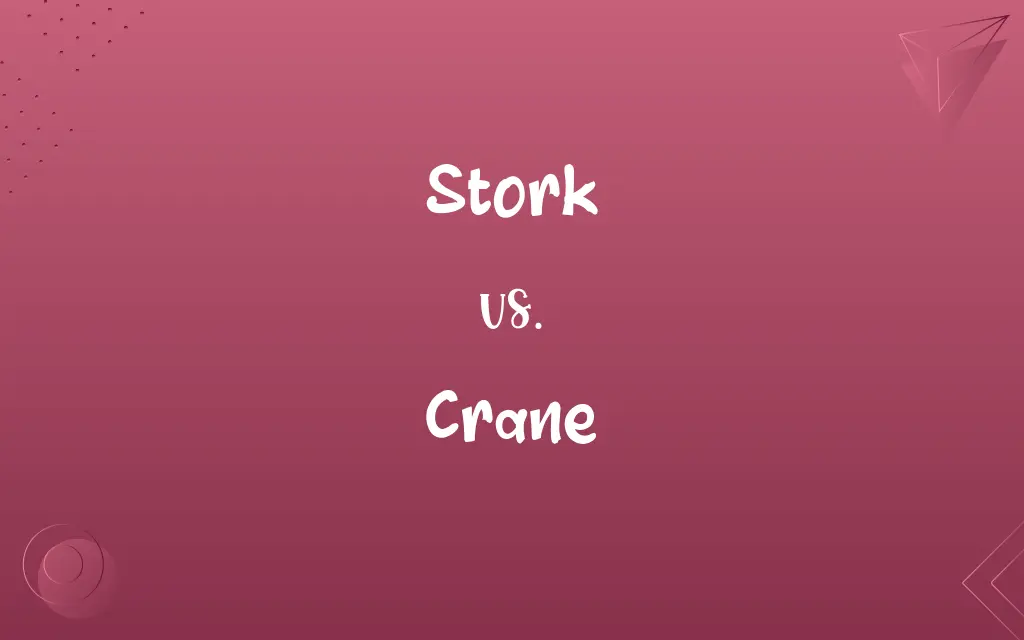Stork vs. Crane: Know the Difference

By Shumaila Saeed || Published on February 24, 2024
Storks are large, long-legged birds known for their straight bills and silent nature, while cranes are similar but larger, with a distinctive loud call and a penchant for dancing.

Key Differences
Storks are large, wading birds with long legs, necks, and straight bills. They are part of the family Ciconiidae and are known for their silent nature, as most storks do not have a well-developed syrinx and are less vocal. In contrast, cranes are also large, long-legged and long-necked birds but belong to the family Gruidae. Cranes are notable for their loud, trumpeting calls, which are made possible by a long, coiled trachea that amplifies their sound.
Shumaila Saeed
Feb 24, 2024
In terms of behavior, storks are often seen standing silently in water or fields, waiting patiently to catch their prey, which includes fish, frogs, and insects. Cranes, however, are more social birds and are famous for their elaborate dancing rituals, which include bowing, jumping, and wing flapping, often performed during courtship.
Shumaila Saeed
Feb 24, 2024
Regarding nesting habits, storks typically build large stick nests which can be used for several years. These nests are often located on buildings, trees, or on the ground, depending on the species. Cranes, on the other hand, usually build their nests in wetlands and are known to return to the same nesting site year after year.
Shumaila Saeed
Feb 24, 2024
A key physical difference between storks and cranes is in their flight. When flying, storks keep their necks outstretched, while cranes are known for their unique ‘V’ formation during migration, which is a spectacular sight. Additionally, cranes fly with their necks straight out and legs trailing behind, a style distinct from storks.
Shumaila Saeed
Feb 24, 2024
Comparison Chart
ADVERTISEMENT
Nesting Habits
Large stick nests, varied locations
Nests in wetlands, site fidelity
Shumaila Saeed
Feb 24, 2024
Flight Pattern
Neck outstretched, less formation flying
Neck straight, ‘V’ formation flying
Shumaila Saeed
Feb 24, 2024
Stork and Crane Definitions
Stork
Storks are known for their silent nature due to less vocal capability.
Unlike other birds, the stork in our backyard was remarkably silent.
Shumaila Saeed
Jan 13, 2024
ADVERTISEMENT
Crane
A crane is a tall, long-necked bird known for its loud call.
The crane's trumpeting call echoed across the wetlands.
Shumaila Saeed
Jan 13, 2024
Stork
Storks often symbolize birth and are part of many cultural folklore.
The storybook had a stork delivering a baby, a common myth.
Shumaila Saeed
Jan 13, 2024
Crane
Cranes are often found in wetlands, marshes, and grassy plains.
The marsh was home to a large flock of cranes.
Shumaila Saeed
Jan 13, 2024
Stork
A stork is a large, long-legged wading bird with a straight bill.
The stork stood gracefully by the riverbank.
Shumaila Saeed
Jan 13, 2024
Crane
Cranes migrate long distances in a distinctive ‘V’ formation.
The sky was filled with cranes flying in a perfect ‘V’.
Shumaila Saeed
Jan 13, 2024
ADVERTISEMENT
Stork
Storks are migratory birds, traveling long distances seasonally.
Each spring, we watch storks return to their nesting site.
Shumaila Saeed
Jan 13, 2024
Crane
Any of various large wading birds of the family Gruidae, having a long neck, long legs, and a long bill.
Shumaila Saeed
Jan 12, 2024
Stork
Any of various large wading birds of the family Ciconiidae, having long legs and a long straight bill.
Shumaila Saeed
Jan 12, 2024
Stork
A large wading bird with long legs and a long beak of the family Ciconiidae.
Shumaila Saeed
Jan 12, 2024
Crane
A machine for hoisting and moving heavy objects by means of cables attached to a movable boom.
Shumaila Saeed
Jan 12, 2024
Stork
(children's folklore) The mythical bringer of babies to families, or good news.
Shumaila Saeed
Jan 12, 2024
Crane
Any of various devices with a swinging arm, as in a fireplace for suspending a pot.
Shumaila Saeed
Jan 12, 2024
Stork
Any one of several species of large wading birds of the family Ciconidæ, having long legs and a long, pointed bill. They are found both in the Old World and in America, and belong to Ciconia and several allied genera. The European white stork (Ciconia alba) is the best known. It commonly makes its nests on the top of a building, a chimney, a church spire, or a pillar. The black stork (C. nigra) is native of Asia, Africa, and Europe.
Shumaila Saeed
Jan 12, 2024
Crane
To strain and stretch (the neck, for example) in order to see better.
Shumaila Saeed
Jan 12, 2024
Stork
Large mostly Old World wading birds typically having white-and-black plumage
Shumaila Saeed
Jan 12, 2024
Stork
Storks have diverse diets, including fish, insects, and small animals.
The stork swept down to catch a fish in its long beak.
Shumaila Saeed
Jan 13, 2024
Crane
Any bird of the family Gruidae, large birds with long legs and a long neck which is extended during flight.
Shumaila Saeed
Jan 12, 2024
Crane
A mechanical lifting machine or device, often used for lifting heavy loads for industrial or construction purposes.
Shumaila Saeed
Jan 12, 2024
Crane
An iron arm with horizontal motion, attached to the side or back of a fireplace for supporting kettles etc. over the fire.
Shumaila Saeed
Jan 12, 2024
Crane
(nautical) A forked post or projecting bracket to support spars, etc.; generally used in pairs.
Shumaila Saeed
Jan 12, 2024
Crane
A wading bird of the genus Grus, and allied genera, of various species, having a long, straight bill, and long legs and neck.
Shumaila Saeed
Jan 12, 2024
Crane
Any arm which swings about a vertical axis at one end, used for supporting a suspended weight.
Shumaila Saeed
Jan 12, 2024
Crane
A machine for raising and lowering heavy weights, and, while holding them suspended, transporting them through a limited lateral distance. In one form it consists of a projecting arm or jib of timber or iron, a rotating post or base, and the necessary tackle, windlass, etc.; - so called from a fancied similarity between its arm and the neck of a crane See Illust. of Derrick.
Shumaila Saeed
Jan 12, 2024
Crane
An iron arm with horizontal motion, attached to the side or back of a fireplace, for supporting kettles, etc., over a fire.
Shumaila Saeed
Jan 12, 2024
Crane
A forked post or projecting bracket to support spars, etc., - generally used in pairs. See Crotch, 2.
Shumaila Saeed
Jan 12, 2024
Crane
To cause to rise; to raise or lift, as by a crane; - with up.
What engines, what instruments are used in craning up a soul, sunk below the center, to the highest heavens.
An upstart craned up to the height he has.
Shumaila Saeed
Jan 12, 2024
Crane
To stretch, as a crane stretches its neck; as, to crane the neck disdainfully.
Shumaila Saeed
Jan 12, 2024
Crane
To reach forward with head and neck, in order to see better; as, a hunter cranes forward before taking a leap.
The passengers eagerly craning forward over the bulwarks.
Shumaila Saeed
Jan 12, 2024
Crane
Lifts and moves heavy objects; lifting tackle is suspended from a pivoted boom that rotates around a vertical axis
Shumaila Saeed
Jan 12, 2024
Crane
Large long-necked wading bird of marshes and plains in many parts of the world
Shumaila Saeed
Jan 12, 2024
Crane
Stretch (the neck) so as to see better;
The women craned their necks to see the President drive by
Shumaila Saeed
Jan 12, 2024
Crane
Cranes engage in elaborate dancing behaviors, especially in mating rituals.
We watched in awe as the cranes performed their dance.
Shumaila Saeed
Jan 13, 2024
Crane
Cranes are symbols of longevity and fidelity in many cultures.
The crane is revered in Asian cultures for its graceful longevity.
Shumaila Saeed
Jan 13, 2024
Repeatedly Asked Queries
Why do cranes dance?
Cranes dance as part of their courtship rituals and social interactions.
Shumaila Saeed
Feb 24, 2024
Where do storks typically nest?
Storks build large stick nests in various locations, including buildings and trees.
Shumaila Saeed
Feb 24, 2024
What distinguishes a crane's call?
Cranes are known for their loud, trumpeting calls.
Shumaila Saeed
Feb 24, 2024
Can storks make vocal sounds?
Storks are mostly silent as they lack a developed syrinx.
Shumaila Saeed
Feb 24, 2024
Are cranes solitary or social?
Cranes are social birds, often seen in groups, especially during migration.
Shumaila Saeed
Feb 24, 2024
What are storks known for in folklore?
Storks are often associated with delivering babies in folklore.
Shumaila Saeed
Feb 24, 2024
How do cranes fly during migration?
Cranes fly in a ‘V’ formation and have a straight neck posture in flight.
Shumaila Saeed
Feb 24, 2024
What is the size of a stork?
Storks vary in size but are generally large, tall birds with long legs.
Shumaila Saeed
Feb 24, 2024
Are storks endangered?
Some stork species are endangered or threatened due to habitat loss.
Shumaila Saeed
Feb 24, 2024
What do storks eat?
Storks have a varied diet, including fish, insects, and small animals.
Shumaila Saeed
Feb 24, 2024
What threats do cranes face?
Cranes face threats like habitat destruction and climate change.
Shumaila Saeed
Feb 24, 2024
What habitats do cranes prefer?
Cranes are typically found in wetlands, marshes, and open plains.
Shumaila Saeed
Feb 24, 2024
What is the flight speed of a stork?
Storks can fly at speeds of about 20-30 mph.
Shumaila Saeed
Feb 24, 2024
Can cranes be found globally?
Cranes are found in many parts of the world, but not globally.
Shumaila Saeed
Feb 24, 2024
Do storks return to the same nesting site?
Many storks return to the same nesting site each year.
Shumaila Saeed
Feb 24, 2024
How do storks communicate?
Storks communicate mainly through body language and visual displays.
Shumaila Saeed
Feb 24, 2024
Are cranes cultural symbols?
Yes, cranes are symbols of longevity and fidelity in various cultures.
Shumaila Saeed
Feb 24, 2024
Share this page
Link for your blog / website
HTML
Link to share via messenger
About Author
Written by
Shumaila SaeedShumaila Saeed, an expert content creator with 6 years of experience, specializes in distilling complex topics into easily digestible comparisons, shining a light on the nuances that both inform and educate readers with clarity and accuracy.








































































